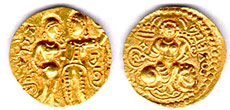 When the kingdom of Delhi was passed on to another dynasty of the Khiljis in the 1290 A.D, a new change was made in the currency by the Khilji rulers. The Khilji rulers reigned between 1290 and 1320 A.D. The five rulers of this dynasty introduced new patterns in the system of currency.
When the kingdom of Delhi was passed on to another dynasty of the Khiljis in the 1290 A.D, a new change was made in the currency by the Khilji rulers. The Khilji rulers reigned between 1290 and 1320 A.D. The five rulers of this dynasty introduced new patterns in the system of currency.
The first two rulers of the Khilji dynasty, Jalaluddin Firoz and Ruknuddin Ibrahim followed the coins of Balban in almost all respects. The third ruler of this dynasty, Alauddin Khilji had enriched his treasury by conquests in South India. He issued voluminous coins during his time. He and his successor, Qutbuddin Mubarak Shah, issued gold and silver `tankah` and coins of heavy weight. Alauddin had issued gold coins weighing 5, 10, 50 and 100 tolas (unit). His son Qutbuddin Mubarak issued gigantic coins of both gold and silver coins in no less than fourteen denominations in two shapes, round and square. These coins were also issued in 5, 10, 20, 30, 40, 50, 60, 70, 80, 90, 100, 150 and 200 tolas. Though these coins were issued by the ruler of Khilji dynasty, no specimens had been found. Only the mint master of the Delhi mint, Thakkur Pheru, had referred to them in his accounts of the working of the mint, of which he was in charge during the reign of these rulers. These coins belonged to a Sultan of Malwa and the Mughal emperors. According to the scholars, these coins were the massive blocks of metal of artistically stamped bullion which were hoarded as stores of value. These coins were occasionally given to ambassadors, diplomatic agents and other distinguished persons as complimentary gifts or souvenirs of imperial favour and magnanimity.
As per the historical evidences, Alauddin Khilji changed the pattern of the inscriptions of the coins. He dropped the name of the Khalifa from the obverse side of his gold and silver coins. He introduced the self laudatory title `Sikandar-us-sant Yamin-ul-khilafat` which was the connotation of the second Alexander, the right hand of the `Khilafat`. Qutbuddin Mubarak used an even more arrogant title, `Al-imam al-azam Khalifa rub al-almin`, which defined the supreme head of Islam, the Khalifa, the lord of the heaven and the earth. The gold and silver coins, from the very beginning of their issue by the Sultans of Delhi, including Muhammad bin Sam, were identical in their content i.e. inscription, fabric and weight.
Firoz Khilji and Alauddin Khilji retained on their billon coins the bilingual reverse introduced by Balban. Meanwhile, Alauddin Khilji introduced another type of coin where his name and title were divided on the two sides of the coins. This type was followed by his successors. Qutbuddin Mubarak added a few more types of coins to it. All the billon coins were known by the name of `Kani` or `gani` and carried a number of denominations. The denominations of the coins were named typically like `eggani` for one, `dugani` for two, `chaugani` for four, `chhagani` for six, `athagani` for eight, `baragani` for twelve, `chaubisagani` for twenty four and `arhtalis-gani` for forty eight. Above them was the silver `tankah` which was valued at sixty `ganis`. Thus `gani` was the unit coin and was known as `jital` in the pre-Khilji period and `dam` in the Khilji and later eras. The values of the `ganis` were dependent on the proportions of the copper and silver metals mixed on them. According to the historical evidences, an `eggani` coin contained 95 percent of copper and 5 percent of silver; `dugani` contained 9.75 percent of silver; a `chaugani` contained 16.4 percent of the white metal. Likewise the percentage of silver in the other coins increased. The other three bigger denominations had a higher weight in proportion to their value, determined by the weight of the `athagani` coins and they contained silver in the same proportion. Even, Alauddin Khilji issued coins from Deogir, when he led his expedition there and occupied it. He also issued coins from Ranthambhor after its conquest under the name of Darul-Islam, which he gave to it. After him, his successor, Qutbuddin Mubarak changed the name of Deogir to Qutbabad and issued coins containing this name. The names of some other places were also found on the coins and it had been said that these coins were issued during military campaigns.
Thus, these coins were noteworthy phenomenon in the numismatic history of India. The coins of Khilji dynasty brought a change in the then economical stature of the society.









